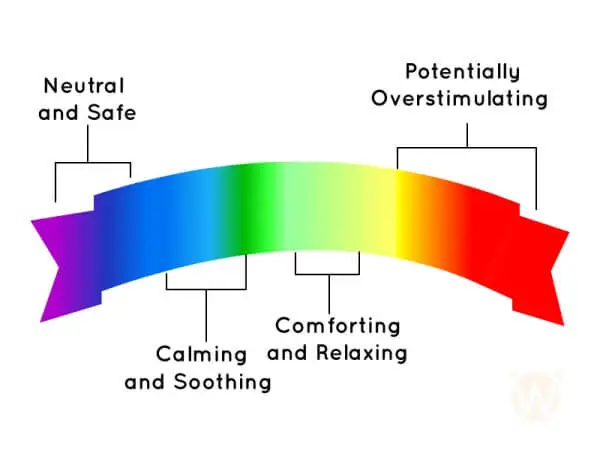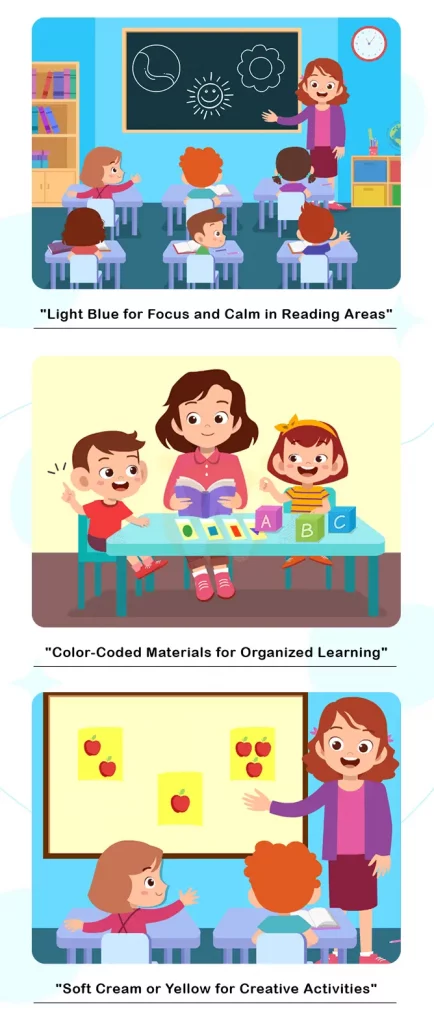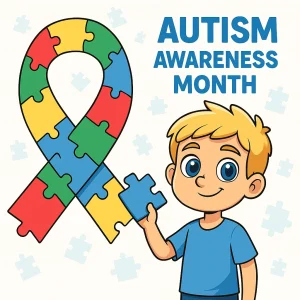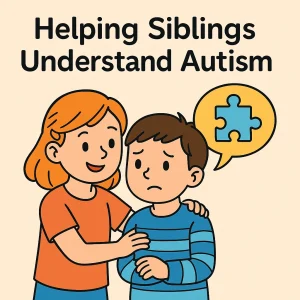The Effect of Colors in Autistic Children | Color Preferences in Children with Autism
By Prapoorna M
Last Updated: November 27, 2021
Understanding Autism Spectrum Disorder and Sensory Sensitivity
Autism Spectrum Disorder (ASD) is a complex neurodevelopmental condition that affects how a person perceives the world and interacts with others. Children with ASD often experience heightened sensory sensitivity. This means they may feel overwhelmed by sensory information that others might not notice, such as bright lights, loud noises, or the texture of certain fabrics. Sensory experiences can have a big impact on their daily lives, influencing their mood, behavior, and ability to learn and communicate.
The role of color and light is particularly important for children with autism. These elements can profoundly affect their emotional and physical well-being. Colors and lighting in their environment can either soothe and comfort them or cause discomfort and overstimulation. Understanding how to use colors and light effectively can make a significant difference in the lives of children with ASD, helping them to feel more relaxed, focused, and engaged in their surroundings.
The Science of Color Perception in Autism
How Children with ASD Perceive Colors Differently
Children with ASD often perceive colors in unique ways compared to neurotypical children. Their sensory processing differences can make certain colors appear more intense or overwhelming. For example, what might look like a bright and cheerful yellow to one child could seem glaring and uncomfortable to a child with autism. This difference in perception means that the choice of colors in their environment – like in their rooms, classrooms, or therapy centers – needs careful consideration to ensure their comfort.
Read more on Childhood Apraxia of Speech: Symptoms, Origins & Treatments
Studies on Color Preferences and Aversions
Research has shown that children with autism often prefer certain hues, particularly those that are softer and less intense. Duller tones, pastels, and muted shades are generally more comforting to them. These colors can have a calming effect, helping to reduce feelings of anxiety or overstimulation.

On the other hand, bright and intense colors, such as vivid reds or neon shades, might be less favored. These colors can be too stimulating and may lead to sensory overload, causing discomfort or distress. It’s important to note that each child with ASD is unique, and their preferences can vary. What works for one child may not work for another, making it crucial for caregivers and educators to observe and learn what colors are most soothing or stimulating for each individual child.
By keeping these considerations in mind, parents, caregivers, and educators can create environments that support the sensory needs of children with ASD, using color and light to enhance their comfort and well-being.
Calming Effects of Specific Colors and Light
Calming Influence of Certain Colors
For children with Autism Spectrum Disorder (ASD), specific colors can have a soothing effect, helping to reduce anxiety and create a sense of calm. Green and blue are often cited as colors that can help to relax and soothe children with ASD. These colors are reminiscent of nature – the green of grass and trees, the blue of the sky and water – and can help create a peaceful environment. Pastel shades, which are softer and less intense, are also beneficial. These colors are not as overwhelming as brighter tones and can help to create a sense of tranquility in a room.
Also read: Parents Guide to Sensory Integration and Occupational Therapy
Color Preferences and Effects
| Color | Common Reaction in AS | Suggested Use |
|---|---|---|
| Green | Soothing, Reduces Anxiety | Good for Relaxation Areas |
| Blue | Calming, Encourages Serenity | Useful in Bedrooms, Quiet Spaces |
| Red | Can Be Overstimulating | Limited Use, Accent Pieces |
| Yellow | Stimulating, Increases Alertness | Activity Areas, Playrooms |
| Pastels | Comforting, Relaxing | Ideal for General Living Spaces |
| Muted Shades | Neutral and Safe | Flexible Use Across Home |
The Role of Light Intensity and Quality
The intensity and quality of light are just as important as color choices. Children with ASD often have sensitivities to bright or flickering lights, which can be distressing and lead to discomfort. Preferences for natural light are common, as it tends to be softer and less harsh than artificial lighting. However, when natural light isn’t available, soft, diffused artificial lighting can be a good alternative. This type of lighting minimizes shadows and glare, which can be problematic for some children with autism. Dimmer switches can be particularly useful as they allow for adjustment of light levels to suit the individual needs of the child.
The Role of Color in Learning and Development
Influence of Color Preferences on Learning
Color can play a significant role in the learning and cognitive development of children with ASD. Certain colors can help to increase concentration and focus, making learning activities more engaging and less overwhelming. For example, softer hues like light blue or cream can create a calming background that makes it easier for children with ASD to focus on tasks without becoming distracted or overstimulated.

Enhancing Task Performance with Color
Specific colors can also be used to enhance task performance and reading ability. For instance, using color-coded materials can help children with ASD to organize information and process it more effectively. Colors can be used to highlight key points or to differentiate between different types of tasks. This visual support can aid in understanding and retaining information. In reading activities, colored overlays or filters can make the text more readable for some children with autism, reducing visual stress and improving comprehension.
Through thoughtful use of color and light, environments can be optimized to support the unique learning and development needs of children with ASD, enhancing their ability to engage and learn effectively.
Designing Autism-Friendly Spaces
Choosing the Right Color Schemes
When selecting colors for spaces used by children with ASD, it’s crucial to opt for hues that promote a calming and secure atmosphere. Here are some practical tips:
Use Soothing Colors: Opt for soft, muted colors like pale blue, gentle green, or warm cream. These colors can help create a serene environment that is conducive to relaxation and concentration.
Avoid Overstimulating Colors: Steer clear of bright, intense colors such as neon shades or vibrant reds, as they can be overwhelming and lead to sensory overload.
Personalize the Space: Pay attention to the child’s individual preferences. Some children may have specific color likes or dislikes, so incorporating their favorite colors can make the space more comforting for them.
Sensory-Friendly Lighting and Color Elements
Incorporating the right lighting and color elements can significantly enhance the functionality and comfort of spaces for children with autism:
Natural Light is Best: Whenever possible, use natural light as it is less harsh and more comforting than artificial light.
Soft Artificial Lighting: In spaces where natural light isn’t sufficient, use soft, diffused artificial light. Avoid fluorescent lights, as they can flicker and cause discomfort.
Use Dimmer Switches: These allow you to adjust light levels according to the child’s needs, which can be particularly helpful during different activities or times of the day.
Color Zones: Use color to define different areas in a room. For example, a quiet corner can be painted in a calming color, while a play area might feature more vibrant but still soothing hues.
Sensory-Friendly Space Design Tips
| Area of House | Color Tips | Lighting Tips |
|---|---|---|
| Bedroom | Soft Blue or Green, promoting calm and rest | Dimmable Lights, allowing adjustment to reduce sensory overload |
| Study Area | Neutral or Pastel Tones, reducing distraction | Bright, Non-flickering Lights, providing clear visibility without causing distress |
| Playroom | Vibrant, But Not Overwhelming, stimulating creativity without overstimulation | Natural Light, if Possible, to make the space feel welcoming and safe |
Read more on What are the Tips for Parenting an Autistic Child? | Helping Your Child with Autism
Navigating Overstimulation and Sensory Sensitivities
Managing Overstimulation from Colors and Lights
Children with ASD can easily become overstimulated by certain colors and light intensities. Here are some strategies to manage this:
Monitor and Adjust: Pay close attention to how the child reacts to different colors and lights, and be ready to make adjustments. For instance, if a certain color seems to cause agitation, consider changing it to a more calming hue.
Gradual Introduction: Introduce new colors and lights gradually to help the child adjust slowly without becoming overwhelmed.
Create a Safe Space: Designate a specific area in the home or classroom where the child can go to relax and recuperate from sensory overload. This space should be painted in calming colors and have soft lighting.
Introducing Sensory-Friendly Toys and Materials
To provide a comforting yet stimulating environment, consider these recommendations:
Sensory Toys: Choose toys that are visually appealing but not overstimulating. Look for items with gentle lights, or in soft, pastel colors.
Textured Materials: Incorporate materials with different textures that the child can touch and feel. This can include plush toys, smooth stones, or fabric swatches.
Visual Supports: Use visual aids like colored charts, schedules, and organizers. These can help children with Autism Spectrum Disorder to understand and navigate their daily routines more easily.
By thoughtfully designing spaces and choosing appropriate toys and materials, parents and caregivers can create an environment that supports the needs of children with ASD, helping them to feel comfortable and engaged in their surroundings.
Case Studies and Real-World Applications
Impact Demonstrated through Case Studies
Real-life examples provide valuable insights into how color and light can significantly impact children with Autism Spectrum Disorder. For instance:
Case Study 1: A classroom designed with soft blue and green hues saw a noticeable improvement in the attention spans and calmness of students with ASD. The use of non-flickering, warm lighting also reduced instances of sensory overload.
Case Study 2: Wellness Hub Hyderabad Autism Center implemented a sensory room with adjustable lighting, where children could choose the color and intensity of lights. This choice allowed them to feel in control and reduced anxiety, leading to more effective therapy sessions.
Insights from Professionals and Parents
Therapists, educators, and parents have shared valuable strategies:
Therapists’ Viewpoint: Many therapists recommend using color-coded systems to help children with Autism Spectrum Disorder in organizing their tasks and schedules, finding it aids in reducing anxiety and improving focus.
Educators’ Techniques: Teachers often use soft-colored, non-glare surfaces in classrooms to minimize distractions and create a calming learning environment.
Parents’ Experiences: Parents of Kids with Autism at Wellness Hub Hyderabad Center for Autism have found that incorporating the child’s favorite colors in their bedrooms or play areas can make a significant difference in their comfort and mood stability.
Tools and Resources for Parents and Caregivers
Apps and Tools for Learning and Development
Several apps and tools are designed to utilize color and light elements to support children with ASD:
Autism BASICS: This app uses low-sensitive color preferences to create a reinforcing learning environment, suitable for children with autism. This app helps in engaging the Kids and empowering the parents. It’s not just another app on Autism. It’s an app designed for the whole family.
Speech BASICS: This Speech BASICS app is not just a tool—it’s an extension of a Speech Therapist’s hand, crafted with expertise to support every child’s communication journey, whether they’re on the autism spectrum or simply learning their first words. This app also helps minimize sensory overload and supports speech and language development.
Resources for Further Exploration
For those seeking more information, consider the following:
Books and Guides: There are numerous books and guides available that provide more in-depth information on how to use color and light effectively for children with ASD.
Online Forums and Support Groups: These platforms can be invaluable sources of shared experiences and tips from other parents and professionals.
Explore more about our article on Best Online Speech Therapy in Hyderabad
Conclusion
Creating a supportive environment for children with Autism Spectrum Disorder (ASD) is crucial, and using the right colors and lighting can play a big part in this. By choosing calming colors like pastels and ensuring soft, natural lighting, caregivers can help reduce sensory overload and promote a sense of calm. Personalizing these spaces based on the child’s preferences further supports their comfort and well-being, making everyday activities more manageable and enjoyable.
At Wellness Hub, the focus is on providing resources and guidance to make these adjustments effectively, prioritizing the unique needs of each child with ASD. The aim is to create nurturing spaces that not only soothe but also aid in the children’s development and engagement with the world around them, demonstrating the power of thoughtful design in enhancing the lives of those with ASD.
Frequently asked questions:
1. How do colors affect children with Autism Spectrum Disorder (ASD)?
Colors can have a significant impact on children with ASD. They may perceive colors more intensely or differently than neurotypical children. Certain colors, like soft blues, greens, and pastels, can have a calming effect, while bright and intense colors might be overstimulating and lead to sensory overload.
2. Why is lighting important in the environment of a child with ASD?
Lighting is crucial because children with ASD often have heightened sensitivity to sensory stimuli. Natural light is generally preferred as it is softer and less harsh than artificial lighting. Soft, diffused artificial lighting can also be beneficial, especially if it minimizes flickering, which can be disturbing for some children with autism.
3. Can certain colors improve learning and focus in children with ASD?
Yes, certain colors can enhance learning and focus. For example, cool tones like light blue can create a calming background that helps children with ASD focus on tasks. Using color-coded materials can also help organize information and assist in the learning process.
4. What are some tips for creating an autism-friendly space at home?
To create an autism-friendly space, use calming colors like pastels or soft shades for walls and decorations. Incorporate sensory-friendly lighting, preferably natural light or soft artificial lighting with dimmer controls. Also, consider the child’s individual preferences and include areas in the home where the child can feel relaxed and safe.
5. How can parents and caregivers manage overstimulation from colors and lights?
To manage overstimulation, monitor the child’s reaction to different colors and lights and be ready to make adjustments. Gradually introduce new colors and lights to help the child adjust. Creating a designated calming space with soothing colors and soft lighting can also be helpful.
6. Are there any specific apps or tools that can help children with ASD in relation to color and light sensitivities?
Yes, there are apps like “Catchup Kids” that use low-sensitive color preferences to create a learning environment suitable for children with autism. These apps often focus on minimizing sensory overload and can be tailored to the child’s color and light sensitivities.
7. Is it necessary to consult a professional while designing a space for a child with ASD?
While it’s not always necessary, consulting with a professional, such as an occupational therapist or a special education expert, can provide valuable insights into creating an environment that caters specifically to the child’s needs and sensitivities.
8. What role does color play in dietary preferences for children with ASD?
Color can significantly influence dietary preferences and eating behaviors in children with ASD. Brightly colored foods may attract some children, while others might prefer more subdued tones due to sensory sensitivities. Understanding a child’s color preference can help caregivers present meals in a way that is more appealing and may encourage a varied and nutritious diet.
9. How can caregivers use colors to improve communication and interaction in children with ASD?
Colors can be used as a visual aid to improve communication and interaction. For example, color-coded communication boards or flashcards can help children with ASD express their needs and feelings more clearly. Additionally, using specific colors for routine activities can aid in understanding and following daily schedules, reducing anxiety and improving the child’s ability to interact with others.
10. Are there specific color schemes recommended for therapy and learning tools for children with ASD?
While individual preferences vary, certain color schemes are generally recommended for therapy and learning tools to enhance focus and reduce sensory overload. Soft, neutral colors or pastel backgrounds with contrasting colors for text or key points can help minimize distraction and make information more accessible to children with ASD. These color schemes are designed to be soothing and less likely to cause sensory discomfort, making learning materials more engaging for the child.
About the Author:
Prapoorna Mangalampalli, Psychologist
Prapoorna, an author with dual master’s degrees in Psychology and English, excels in exploring and enhancing human experiences. Her writing, characterized by deep empathy and insight, primarily focuses on the complexities of counseling, spanning areas such as online, marital, relationship, child, family, and career counseling. Specialized training in various counseling sectors underscores her dedication to positive change. In her blogs, Prapoorna offers valuable guidance and a unique perspective for parents of children with Autism and special needs, creating a supportive community in this realm.
Book your Free Consultation Today
Parent/Caregiver Info:
Client’s Details:
* Error Message









